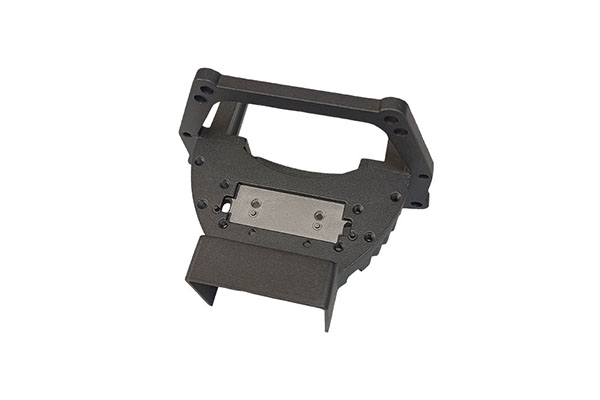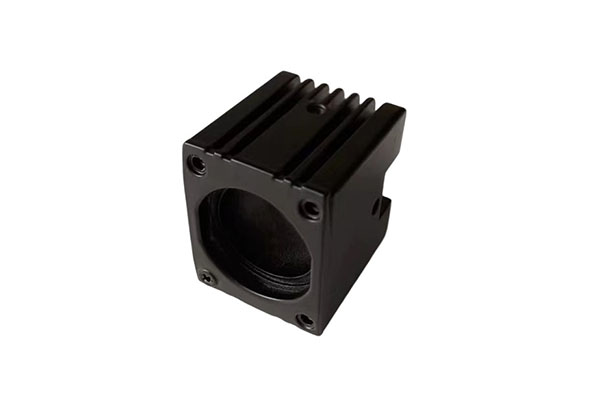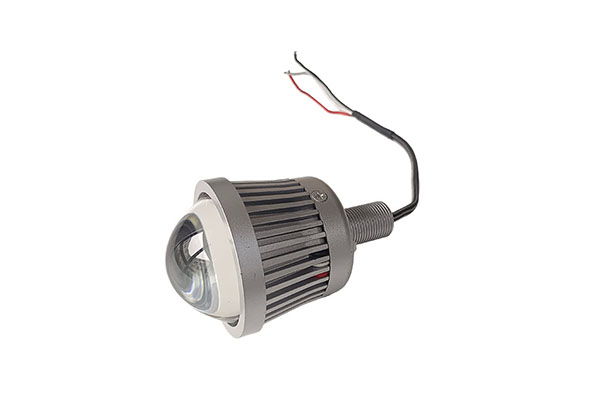How does a car headlight lens bracket ensure that the lens maintains precise optical axis positioning despite driving vibrations?
Release Time : 2025-10-13
In modern automotive lighting systems, lens headlights have become standard equipment in mid- to high-end vehicles due to their advantages, including strong focusing, long illumination distance, and clear light pattern. They are widely used in halogen, xenon, LED, and even laser headlight systems. However, even the most advanced optical design will struggle to achieve optimal performance without stable physical support. As a core structural component that secures and positions the lens, the car headlight lens bracket plays a crucial role in maintaining the lens's precise optical axis in complex driving environments. It is not only a mechanical connector but also an "optical stabilizer" that ensures driving safety and lighting effects.
1. Precision Structural Design: Achieving Three-Dimensional Precision Positioning
Lens brackets typically utilize a "three-point positioning" or "multi-point surround fixation" structure. These brackets are precision-molded to ensure a perfect fit with the curved surface of the lens housing. Clips, threaded holes, or clamping rings on the bracket tightly engage the lens body, restricting its freedom of movement in multiple directions, including vertical, horizontal, and front-to-back, creating a rigid connection. This design effectively prevents lens displacement or rotation caused by inertial forces generated by bumps, acceleration, or cornering during vehicle operation, ensuring that the optical center remains aligned with the preset illumination direction, maintaining the ideal low-beam tangent and high-beam focus.
2. High-strength materials ensure long-term stability
To withstand long-term vibration and temperature fluctuations, lens mounts are generally made of highly rigid, age-resistant engineering materials. Common examples include reinforced nylon, polycarbonate, or aluminum alloy die-casting. These materials offer excellent tensile strength, creep resistance, and thermal stability, resisting deformation or embrittlement even in extreme temperatures ranging from -40°C to 120°C. Metal mounts, in particular, are often used in high-end vehicles or modified lens systems. Their higher density and rigidity further suppress high-frequency vibrations, ensuring that the optical axis maintains factory accuracy even after tens of thousands of kilometers of driving.
3. Anti-loosening and shock-absorbing structural design: Coping with continuous vibrations
Driving on gravel roads, changing lanes on highways, or on pothole-prone surfaces can produce continuous and irregular vibrations. To this end, high-quality lens brackets often incorporate anti-loosening features such as elastic washers, locknuts, self-tapping threads, or rubber cushions. These designs provide a continuous preload after the screws or clips are tightened, preventing loosening due to vibration. Some brackets also incorporate silicone pads or soft cushioning layers at key contact points to provide localized shock absorption, absorb high-frequency vibration energy, and prevent stress from being directly transferred to the lens body, thereby protecting the optical components from damage.
4. Collaborative Fixing with the Headlamp Housing: Creating a Stable Integration
The lens bracket does not operate independently; instead, it forms an integrated fixing system with the headlamp assembly housing. The bracket is securely attached to the pre-set mounting points on the inner wall of the headlamp housing using bolts or clips, while the housing itself is connected to the vehicle body through multiple points of attachment. This four-level stabilization structure of "body-lamp housing-bracket-lens" securely locks the lens in the vehicle coordinate system, significantly reducing the risk of optical axis deviation due to local loosening. Some high-end models also feature automatic leveling motors, whose actuators are integrated into the bracket system. This allows for dynamic adjustment of the optical axis angle as the vehicle load changes, further enhancing lighting safety.
5. Adaptability and Craftsmanship Precision: Ensuring Installation Consistency
Each lens bracket is custom-made for a specific vehicle or lens model. 3D modeling is used to match the actual vehicle, ensuring that the lens' optical axis is perfectly aligned with the headlight reflector cavity and sunshade after installation. Even for the aftermarket, professional lens kits offer high-precision brackets that, when installed, are aligned with a spirit level and dimming platform to prevent glare or blind spots caused by misalignment. Non-standard brackets made by hand welding or inferior injection molding often suffer from large tolerances and low strength, making them prone to deformation during use and seriously compromising driving safety.
Although small, the car headlight lens bracket is the key to reliable lighting system operation. Through its sophisticated structural design, high-strength materials, anti-loosening and vibration-damping technology, and systematic installation process, it securely locks the lens' optical axis in place, ensuring that light remains stable, free of drift, and glare, even under the complex conditions of long-term driving. This seemingly insignificant component silently safeguards the safety margins of nighttime driving, ensuring that every beam of light accurately illuminates the road ahead.
1. Precision Structural Design: Achieving Three-Dimensional Precision Positioning
Lens brackets typically utilize a "three-point positioning" or "multi-point surround fixation" structure. These brackets are precision-molded to ensure a perfect fit with the curved surface of the lens housing. Clips, threaded holes, or clamping rings on the bracket tightly engage the lens body, restricting its freedom of movement in multiple directions, including vertical, horizontal, and front-to-back, creating a rigid connection. This design effectively prevents lens displacement or rotation caused by inertial forces generated by bumps, acceleration, or cornering during vehicle operation, ensuring that the optical center remains aligned with the preset illumination direction, maintaining the ideal low-beam tangent and high-beam focus.
2. High-strength materials ensure long-term stability
To withstand long-term vibration and temperature fluctuations, lens mounts are generally made of highly rigid, age-resistant engineering materials. Common examples include reinforced nylon, polycarbonate, or aluminum alloy die-casting. These materials offer excellent tensile strength, creep resistance, and thermal stability, resisting deformation or embrittlement even in extreme temperatures ranging from -40°C to 120°C. Metal mounts, in particular, are often used in high-end vehicles or modified lens systems. Their higher density and rigidity further suppress high-frequency vibrations, ensuring that the optical axis maintains factory accuracy even after tens of thousands of kilometers of driving.
3. Anti-loosening and shock-absorbing structural design: Coping with continuous vibrations
Driving on gravel roads, changing lanes on highways, or on pothole-prone surfaces can produce continuous and irregular vibrations. To this end, high-quality lens brackets often incorporate anti-loosening features such as elastic washers, locknuts, self-tapping threads, or rubber cushions. These designs provide a continuous preload after the screws or clips are tightened, preventing loosening due to vibration. Some brackets also incorporate silicone pads or soft cushioning layers at key contact points to provide localized shock absorption, absorb high-frequency vibration energy, and prevent stress from being directly transferred to the lens body, thereby protecting the optical components from damage.
4. Collaborative Fixing with the Headlamp Housing: Creating a Stable Integration
The lens bracket does not operate independently; instead, it forms an integrated fixing system with the headlamp assembly housing. The bracket is securely attached to the pre-set mounting points on the inner wall of the headlamp housing using bolts or clips, while the housing itself is connected to the vehicle body through multiple points of attachment. This four-level stabilization structure of "body-lamp housing-bracket-lens" securely locks the lens in the vehicle coordinate system, significantly reducing the risk of optical axis deviation due to local loosening. Some high-end models also feature automatic leveling motors, whose actuators are integrated into the bracket system. This allows for dynamic adjustment of the optical axis angle as the vehicle load changes, further enhancing lighting safety.
5. Adaptability and Craftsmanship Precision: Ensuring Installation Consistency
Each lens bracket is custom-made for a specific vehicle or lens model. 3D modeling is used to match the actual vehicle, ensuring that the lens' optical axis is perfectly aligned with the headlight reflector cavity and sunshade after installation. Even for the aftermarket, professional lens kits offer high-precision brackets that, when installed, are aligned with a spirit level and dimming platform to prevent glare or blind spots caused by misalignment. Non-standard brackets made by hand welding or inferior injection molding often suffer from large tolerances and low strength, making them prone to deformation during use and seriously compromising driving safety.
Although small, the car headlight lens bracket is the key to reliable lighting system operation. Through its sophisticated structural design, high-strength materials, anti-loosening and vibration-damping technology, and systematic installation process, it securely locks the lens' optical axis in place, ensuring that light remains stable, free of drift, and glare, even under the complex conditions of long-term driving. This seemingly insignificant component silently safeguards the safety margins of nighttime driving, ensuring that every beam of light accurately illuminates the road ahead.







